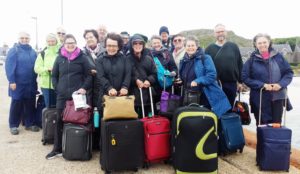 Marlene Kropf is a spiritual director, retreat leader and retired Anabaptist Mennonite Biblical Seminary professor who now lives in Port Townsend, Washington, with her husband Stanley, who enjoys sailing on nearby waters. Marlene is a member of the Mennonite Spiritual Directors Network.
Marlene Kropf is a spiritual director, retreat leader and retired Anabaptist Mennonite Biblical Seminary professor who now lives in Port Townsend, Washington, with her husband Stanley, who enjoys sailing on nearby waters. Marlene is a member of the Mennonite Spiritual Directors Network.
In spring, Chaucer wrote, “folk long to go on pilgrimages.” Nowadays, the desire to go on a pilgrimage might erupt in any season of the year. Ironically, as church attendance continues to decline in the West, the number of people – Christian and otherwise – who go on pilgrimages continues to increase.
Ancient Irish Christians understood that to go on a pilgrimage was “to seek the place of one’s resurrection.”
Pilgrimage was an embodied prayer, an engagement of the entire person – body, mind, heart and spirit.
Wherever they traveled, pilgrims opened themselves to the movement and direction of God’s Spirit, seeking transformation into Christlikeness.
Recently someone pointed out to me that a pilgrimage has six identifiable stages. An initial yearning or longing invites us to a particular place or experience. Then comes preparation for the journey: reading, prayer and discernment, conversation with other pilgrims, checking out websites and deciding what to take along. We establish an itinerary for our journey: where we will travel, when, with whom and why. As the journey begins, we eagerly anticipate our arrival, even though we must first endure leaving behind what is known and familiar in order to enter the promised future. The sacred experience includes the events, encounters and solitude of the journey in which God’s call to new life is made known to us. At last, we return to our homes – refreshed, transformed and sometimes chastened by all we’ve experienced. Re-entering our familiar lives, we seek to integrate new images and learnings into our call to daily discipleship.

Marlene and Stanley Kropf recently led a group of 16 pilgrims on a Celtic Spiritual Pilgrimage to the Isle of Iona in Scotland (pictured above) as well as to Celtic sites in England, Northern Ireland and the Republic of Ireland.
Favorite places of spiritual pilgrimage today include the Camino in Spain; Celtic sites in Scotland, England and Ireland; the Holy Land; Assisi or Rome; early Anabaptist centers in Switzerland and Holland; or contemporary American settings connected with historical events such as the Civil Rights movement or the forced migration of Native Americans on the Trail of Tears. New pilgrim paths emerge as the desire to encounter these sacred stories continues to grow. For example, in Ireland one can literally walk across the land in the path of Saint Brigid or Saint Patrick. In Scotland and England one can walk on the path of Saint Columba, Saint Cuthbert or on the Canterbury Trail. As people listen deeply to stories of the past, they discern in fresh ways how God’s Spirit is calling us to live today.
We need not travel far to reap the spiritual fruits of pilgrimage.
Choosing to bike or walk on a Sunday morning to our place of worship can be a spiritual pilgrimage as we pass through familiar or unfamiliar neighborhoods, listening intentionally to the voice of God’s Spirit along the way.
Perhaps one of the richest benefits of pilgrimage is new relationships: encounters with strangers or deepened communion with fellow pilgrims. Praying together morning and night, sharing meals, enduring the rigors of travel and reflecting together on both the inner and outer journeys bonds people and strengthens their faith. They catch a vision of what ordinary church life might be like if the same practices were engaged at home.
Perhaps spiritual pilgrimages can be a key to spiritual renewal in our time.
Just as other spiritual practices in the past called the church to greater faithfulness, it may be that the embodied prayer of pilgrimage is one way the Spirit is working to transform the church today.
If the Spirit is calling you to go on pilgrimage, listen well!

